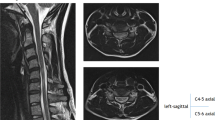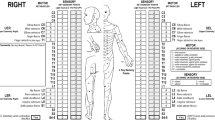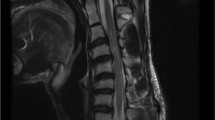Abstract
Introduction:
Hirayama disease, a type of cervical flexion myelopathy, is a rare neurological disease characterized by muscular atrophy of the forearms and hands. Generally, the pathology is limited to the gray matter of the anterior horns in the lower cervical spinal cord. However, in rare cases the damage can spread to the white matter and present as long tract signs.
Case Presentation:
We report on a 30-year-old female whose onset presented as unilateral muscle atrophy of the right hand in her teens. Despite conservative treatment using a cervical collar, she developed prolonged bilateral muscle atrophy, sensory disturbance and spastic gait, along with bladder and rectal disturbances. Her hands were frozen into a ‘claw-like’ gesture and her intrinsic muscles were highly atrophic. She was unable to unclench her hands. Although the space available for the spinal cord was large, the spinal cord was highly atrophic. She had local kyphosis with a large (61°) flexion range of motion. During flexion the spinal cord was stretched, resulting in contact with the posterior wall of the vertebrae. Posterior fusion surgery was performed to prevent progression of the myelopathy. After surgery, she gained mild improvement in both muscle strength and her hand’s movement. However, her spastic gait and muscle atrophy remained.
Discussion:
Most cases of cervical flexion myelopathy as represented by Hirayama disease have a self-limiting benign prognosis. However, some cases can develop advanced myelopathy with long tract signs. Long-term follow-up is recommended for these cases because they may require early surgical treatment.
Similar content being viewed by others
Log in or create a free account to read this content
Gain free access to this article, as well as selected content from this journal and more on nature.com
or
References
Hirayama K, Tsubaki T, Toyokura Y, Okinaka S . Juvenile muscular atrophy of unilateral upper extremity. Neurology 1963; 13: 373–380.
Iwasaki Y, Tashiro K, Kikuchi S, Kitagawa M, Isu T, Abe H . Cervical flexion myelopathy: a ‘tight dural canal mechanism’. Case report. J Neurosurg 1987; 66: 935–937.
Hirayama K, Tomonaga M, Kitano K, Yamada T, Kojima S, Arai K . Focal cervical poliopathy causing juvenile muscular atrophy of distal upper extremity: a pathological study. J Neurol Neurosurg Psychiatry 1987; 50: 285–290.
Henderson FC, Geddes JF, Vaccaro AR, Woodard E, Berry KJ, Benzel EC . Stretch-associated injury in cervical spondylotic myelopathy: new concept and review. Neurosurgery 2005; 56: 1101–1113.
Fujimoto Y, Oka S, Tanaka N, Nishikawa K, Kawagoe H, Baba I . Pathophysiology and treatment for cervical flexion myelopathy. Eur Spine J 2002; 11: 276–285.
Hosono N, Sakaura H, Mukai Y, Kaito T, Makino T, Yoshikawa H . A simple performance test for quantifying the severity of cervical myelopathy. J Bone Joint Surg Br 2008; 90: 1210–1213.
Yukawa Y, Kato F, Suda K, Yamagata M, Ueta T . Age-related changes in osseous anatomy, alignment, and range of motion of the cervical spine. Part I: radiographic data from over 1,200 asymptomatic subjects. Eur Spine J 2012; 21: 1492–1498.
Brain WR, Northfield D, Wilkinson M . The neurological manifestations of cervical spondylosis. Brain 1952; 75: 187–225.
Keegan JJ . The cause of dissociated motor loss in the upper extremity with cervical spondylosis. J Neurosurg 1965; 23: 528–536.
Hashiguchi S, Ogasawara N, Watanabe A, Kawachi Y, Miki N . Cervical spondylotic amyotrophy associated with Hirayama's disease. Intern Med 1997; 36: 647–650.
Kameyama T, Ando T, Mimatsu K, Sofue G . [Delayed exacerbation of cervical myelopathy in a case of juvenile muscular atrophy of unilateral distal upper extremity]. Rinsho Shinkeigaku 1997; 37: 60–63.
Kameyama T . Relationship between cervical flexion myelopathy and cervical spondylotic amyotrophy. Sekitsui sekizui J 2009; 22: 1147–1155.
Yada K, Tachibana S, Okada K .Spinal cord lesion due to relative imbalance of cervical spine and cervical cord. 1981 Annual Report of prevention and Treatment For The Congenital Anomalies of the Spine and Spinal Cord, The Ministry of Health Welfare of Japan. Vol. S56, 1982, pp 48–55 .
Mitsui K, Iida H, Tachibana S, Yada K . Surgical treatment for flexion myelopathy with overstretch syndrome. Nihon Seikeigeka Gakkai Zasshi 1990; 64: 325.
Kohno M, Takahashi H, Yagishita A, Tanabe H . ‘Disproportion theory’ of the cervical spine and spinal cord in patients with juvenile cervical flexion myelopathy. A study comparing cervical magnetic resonance images with those of normal controls. Surg Neurol 1998; 50: 421–430.
Pradhan S, Gupta RK . Magnetic resonance imaging in juvenile asymmetric segmental spinal muscular atrophy. J Neurol Sci 1997; 146: 133–138.
Breig A, el-Nadi AF . Biomechanics of the cervical spinal cord. Relief of contact pressure on and overstretching of the spinal cord. Acta Radiol Diagn (Stockh) 1966; 4: 602–624.
Breig A, Turnbull I, Hassler O . Effects of mechanical stresses on the spinal cord in cervical spondylosis. A study on fresh cadaver material. J Neurosurg 1966; 25: 45–56.
Reid JD . Effects of flexion-extension movements of the head and spine upon the spinal cord and nerve roots. J Neurol Neurosurg Psychiatry 1960; 23: 214–221.
Penning L, van der Zwaag P . Biomechanical aspects of spondylotic myelopathy. Acta Radiol Diagn 1966; 5: 1090–1103.
Kikuchi S, Shinpo K, Niino M, Higashi T, Tashiro K . Cervical myelopathy due to a ‘tight dural canal in flexion’ with a posterior epidural cavity. Intern Med 2002; 41: 746–748.
Yoshiyama Y, Tokumaru Y, Arai K . Flexion-induced cervical myelopathy associated with fewer elastic fibers and thickening in the posterior dura mater. J Neurol 2010; 257: 149–151.
Mochizuki M, Goto S, Kita T, Kobayashi K, Sodeyama T, Murata J et al. [Evaluation of the dynamicity of spinal cord and dura mater until neck full flexion in flexion myelopathy and the histopathologhy of its dura mater]. Seikeigeka 1996; 47: 162–166.
Kaye KL, Ramsay D, Young GB . Cervical flexion myelopathy after valproic acid overdose. Spine (Phila Pa 1976) 2001; 26: E459–E461; discussion E462.
Morandi X, Riffaud L, Amlashi SF, Brassier G . Extensive spinal cord infarction after posterior fossa surgery in the sitting position: case report. Neurosurgery 2004; 54: 1512–1515;discussion 1515-1516.
Rau CS, Liang CL, Lui CC, Lee TC, Lu K . Quadriplegia in a patient who underwent posterior fossa surgery in the prone position. Case report. J Neurosurg 2002; 96 (1 Suppl): 101–103.
Kato Y, Kataoka H, Ichihara K, Imajo Y, Kojima T, Kawano S et al. Biomechanical study of cervical flexion myelopathy using a three-dimensional finite element method. J Neurosurg Spine 2008; 8: 436–441.
Tokumaru Y, Hirayama K . [Cervical collar therapy for juvenile muscular atrophy of distal upper extremity (Hirayama disease): results from 38 cases]. Rinsho Shinkeigaku 2001; 41: 173–178.
Okamoto Y, Kawahara N, Murakami H, Demura S, Yoshioka K, Tomita K . Cervical flexion myelopathy: two cases report. Tyubu seisaishi 2010; 53: 205–206.
Arrese I, Rivas JJ, Esteban J, Ramos A, Lobato RD . A case of Hirayama disease treated with laminectomy and duraplasty without spinal fusion. Neurocirugia (Astur) 2009; 20: 555–558; discussion 558.
Patel TR, Chiocca EA, Freimer ML, Christoforidis GA . Lack of epidural pressure change with neck flexion in a patient with Hirayama disease: case report. Neurosurgery 2009; 64: E1196–E1197; discussion E1197.
Watanabe K, Hasegawa K, Hirano T, Endo N, Yamazaki A, Homma T . Anterior spinal decompression and fusion for cervical flexion myelopathy in young patients. J Neurosurg Spine 2005; 3: 86–91.
Ito H, Takai K, Taniguchi M . Cervical duraplasty with tenting sutures via laminoplasty for cervical flexion myelopathy in patients with Hirayama disease: successful decompression of a ‘tight dural canal in flexion’ without spinal fusion. J Neurosurg Spine 2014; 21: 743–752.
Sakai K, Ono K, Okamoto Y, Murakami H, Yamada M . Cervical flexion myelopathy in a patient showing apparent long tract signs: a severe form of Hirayama disease. Joint Bone Spine 2011; 78: 316–318.
Shiohara K, Morishita M, Kanzaki K, Saito H, Ochiai J . An experience of antrior decompression fixation for cervical flexion myelopathy. Higashinihon Seisai 2003; 15: 604–607.
Inasaka R, Horii H, Iwamura Y, Ishii M . Posterior cervical fusion for flexion myelopathy. Kanagawa Igakukaizasshi 1999; 26: 343.
Kohno M, Takahashi H, Ide K, Yamakawa K, Saitoh T, Inoue K . Surgical treatment for patients with cervical flexion myelopathy. J Neurosurg 1999; 91 (1 Suppl): 33–42.
Konno S, Goto S, Murakami M, Mochizuki M, Motegi H, Moriya H . Juvenile amyotrophy of the distal upper extremity: pathologic findings of the dura mater and surgical management. Spine (Phila Pa 1976) 1997; 22: 486–492.
Ohnari K, Yamada K, Hachiya M, Fujii H, Fujisita A, Okubo T et al. Pathophysiology of cervical flexion myelopathy in young patients. Rinsho Seikeigeka 1993; 28: 1119–1127.
Kondo S, Ohnari K, Saito Y, Mitsuhashi T, Iwamura Y, Toguchi A et al. Posterior fusion in patients with cervical flexion myelopathy: a report of two cases. Kanto J Orthop Traumatol 1991; 22: 32–39.
Ogasa T, Taniguchi M, Maeda A, Yamamoto K, Samejima S, Aoki Y et al. A case report of anterior spinal fusion for Hirayama's disease. Seikeigeka 1992; 43: 83–87.
Katayama K, Umefuji T, Satou Y, Onodera N, Yasuda M, Harada Y . A case of similar Hirayama's disease with long tract sign. Rinsho Seikeigeka 1990; 25: 672–677.
Masaki T, Hashida H, Sakuta M, Kunogi J . [A case of flexion myelopathy presenting juvenile segmental muscular atrophy of upper extremities--a successful treatment by cervical spine immobilization]. Rinsho Shinkeigaku 1990; 30: 625–629.
Okamoto A, Okawa A, Nakai O, Yamaura I . A case of cervical flexion myelopathy. East Jpn J Clin Orthop 1989; 1: 13–17.
Author information
Authors and Affiliations
Corresponding author
Ethics declarations
Competing interests
The authors declare no conflict of interest.
Additional information
Supplementary Information accompanies this paper on Spinal Cord Series and Cases website
Supplementary information
Rights and permissions
About this article
Cite this article
Fujimori, T., Tamura, A., Miwa, T. et al. Severe cervical flexion myelopathy with long tract signs: a case report and a review of literature. Spinal Cord Ser Cases 3, 17016 (2017). https://doi.org/10.1038/scsandc.2017.16
Received:
Revised:
Accepted:
Published:
DOI: https://doi.org/10.1038/scsandc.2017.16
This article is cited by
-
Hirayama disease associated with neurogenic bladder dysfunction
Acta Neurologica Belgica (2023)
-
Finger trembling improvement after surgery in Hirayama disease: a case report
Spinal Cord Series and Cases (2022)
-
Impact of various cervical surgical interventions in patients with Hirayama’s disease—a narrative review and meta-analysis
Neurosurgical Review (2021)
-
Expert’s Comment concerning Grand Rounds case entitled “Hirayama disease” by D. C. Kieser, P. J. Cox, S. C. J. Kieser (Eur Spine J; 2018: doi:10.1007/s00586-018-5545-9)
European Spine Journal (2018)



